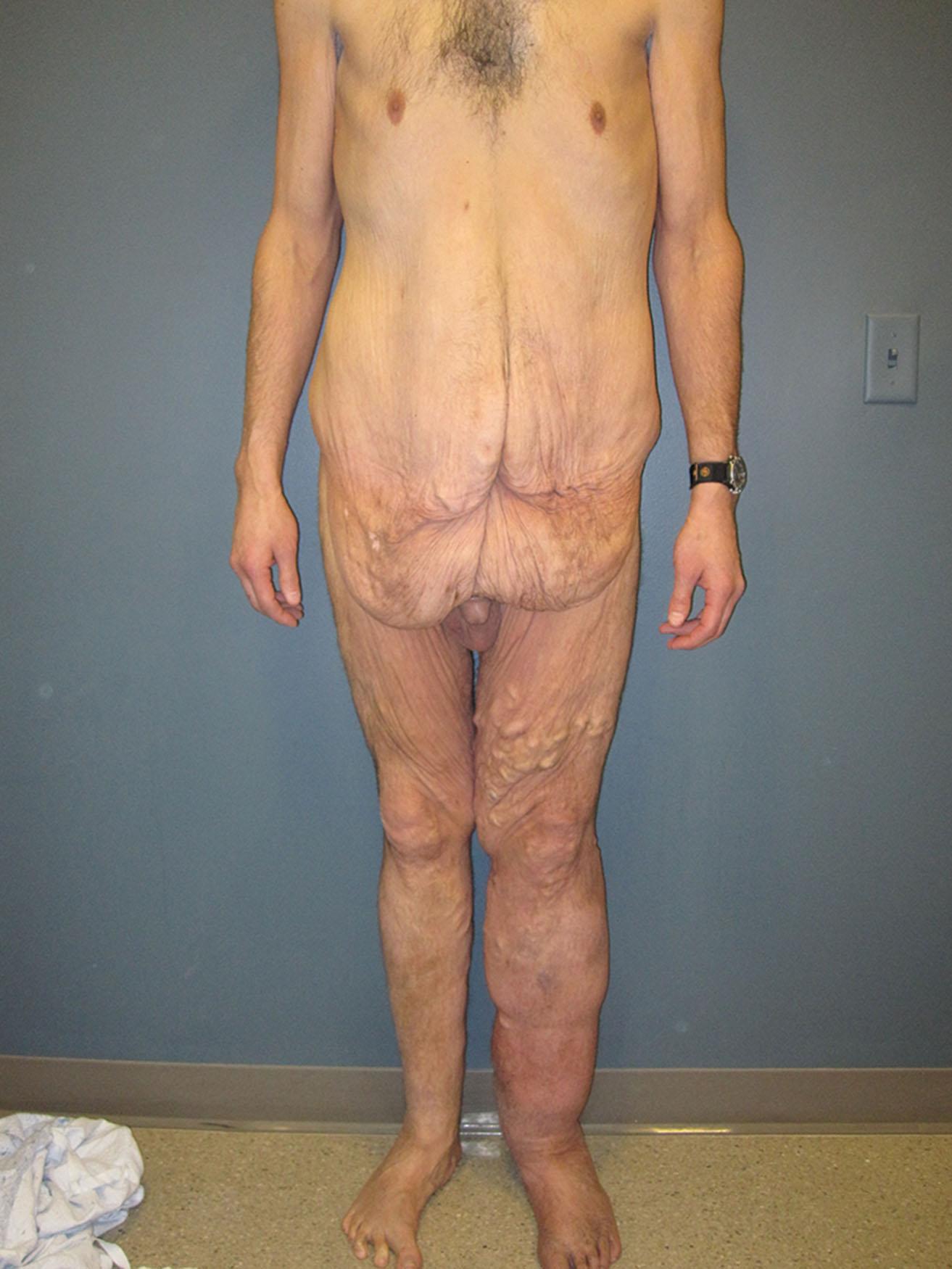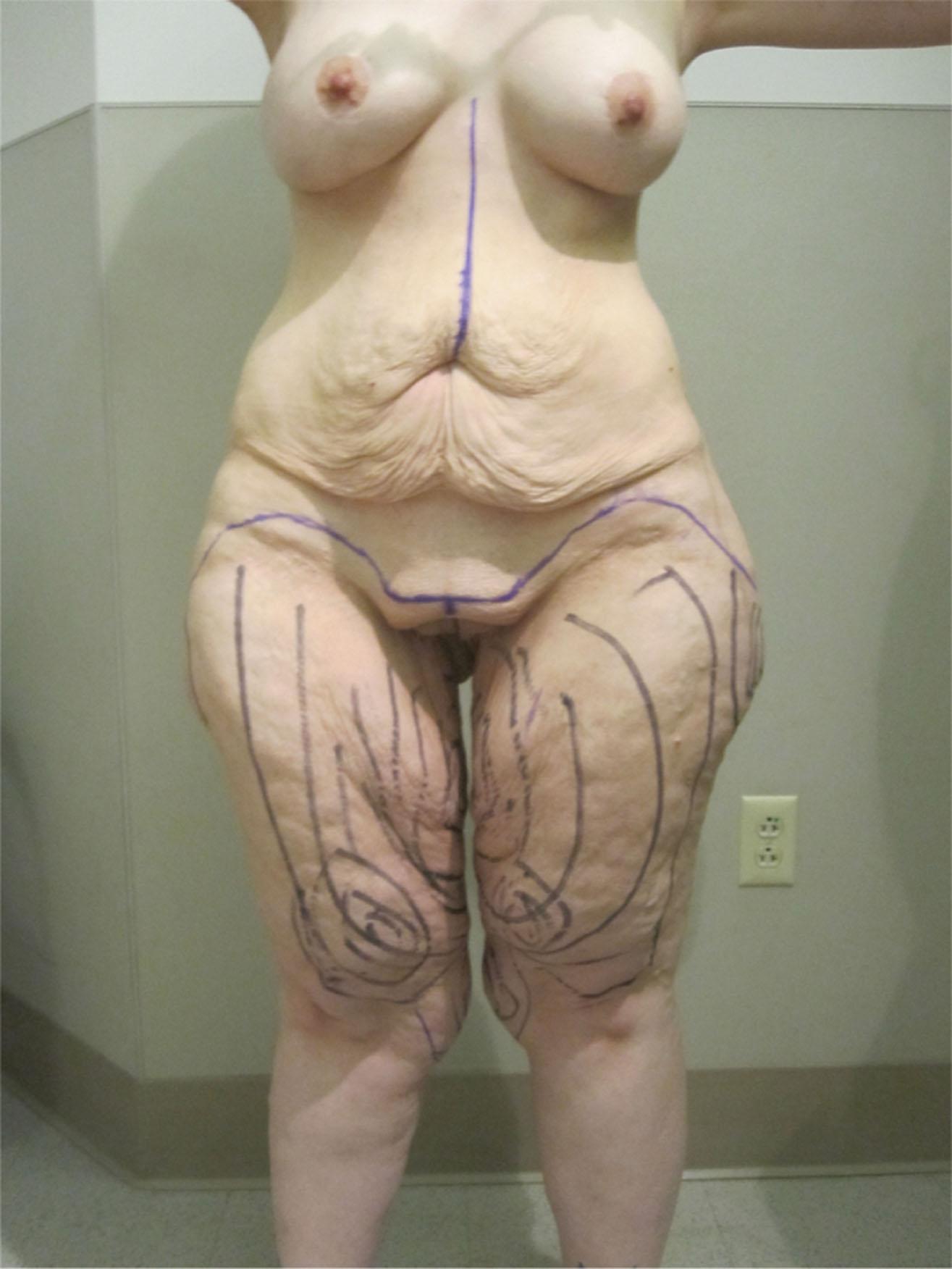Physical Address
304 North Cardinal St.
Dorchester Center, MA 02124
Medial thighplasty has grown in popularity in the massive weight loss population, as they are often left with deformities of the inner and outer thigh.
Not every weight loss patient is a candidate for medial thighplasty.
Medial thighplasty is nuanced, and it is imperative for the plastic surgeon to respect anatomy, danger zones, and structures during this procedure.
Pre-thighplasty liposuction may be utilized in patients that have too much global adiposity in the thigh to accomplish a successful excisional thighplasty.
The crescent or horizontal thighplasty is often used to address skin laxity and concerns of the upper third of the inner thigh.
The short-scar vertical thighplasty is appropriate for patients with skin laxity and ptosis that extends beyond the upper third and into the middle third of the medial thigh.
The full scar vertical thighplasty is used to address excess amount of skin and festoon-like soft tissue that extends down into the lower third of the thigh.
The marking used for the vertical component of the thighplasty is drawn along the medial thigh using the adductor longus muscle as a reference line. A “pinch test” is performed in order to assess mobility of the tissue in the horizontal vector toward the groin in designing the crescentic portion of the thighplasty incision.
Minor complications such as scar migration, wound dehiscence, scar infection, hematoma, lymphedema, suture extrusion, inadequate skin resection and recurrent skin laxity, upper knee fullness, peroneal nerve compression, and gaping vulva are common, and patient should be made aware of this during preoperative assessment ( ![]() ).
).
Access video content for this chapter online at Elsevier eBooks+ ![]()
Medial thighplasty, first described as an aesthetic procedure in 1957, has increased in popularity since the beginnings of bariatric surgery as a solution to obesity and represents one of the most commonly performed plastic surgical procedures today. Once massive weight loss (MWL) patients have met their weight loss goals, plastic surgeons are faced with the challenge of tackling deformities of the outer (lateral) and inner (medial) thigh. A proper history and physical must first be elicited. Skin quality and tone must be assessed, and the surgeon must make note of areas of greatest degree of skin ptosis. Deformities of the outer and medial thigh are each addressed differently. This chapter specifically addresses deformities, treatments, and complications of the medial thigh.
Understanding the anatomy of the medial thigh is essential to performing a successful medial thighplasty. Unlike other areas of the body where body contouring is generally performed, the medial thigh is known for its thin epidermal and dermal layers. Just beyond the dermis are two layers of adipose tissue, which are separated by a superficial fascial system. Beyond both layers of subcutaneous fat lies the strong Colles’ fascia, which was described by Lockwood as the deep layer of the superficial perineal fascia. Colles’ fascia makes attachments to the ischiopubic rami of the bony pelvis, to Scarpa’s fascia of the abdominal wall, and to the posterior border of the urogenital diaphragm. It is best found intra-operatively by dissecting at the origin of the adductor muscles on the ischiopubic ramus and retracting the skin and superficial fat of the vulva medially as it lies at the deepest and most lateral aspect of the vulvar soft tissue. It is also imperative to avoid the femoral triangle, bordered by the inguinal ligament superiorly, adductor longus medially, and sartorius muscle laterally, which lies lateral to the Colles’ fascia dissection, to prevent major neurovascular injury as well as minimize disruption of the lymphatic channels, which run in this anatomic region.
Although the medial thigh lift was first described by Lewis in 1957, it did not initially gain popularity due to ensuing postoperative complications such as scar migration, vulvar deformity, and recurrence of ptosis. Thighplasty went on to gain more widespread acceptance when Lockwood began anchoring dermis to the Colles’ fascia to mitigate scar migration and inspire more durable and longstanding surgical results.
Surgical recommendations for each MWL patient are highly dependent on degree and location of lipodystrophy and skin laxity. These are outlined in Table 37.1 . It is extremely important to set realistic expectations during the initial consultation. When a patient comes into the office, it is important to assess the thigh as a whole, as the inner and outer thighs require different corrective surgical approaches. Outer thigh ptosis, best addressed by a lower body lift procedure, is addressed in another chapter. From this point forward, we continue our discussion of the inner thigh. In general, patients with medial laxity limited to the upper third of the thigh benefit from horizontal skin excision, while patients with laxity extending to the middle third of the thigh benefit from short-scar vertical thighplasty. For patients with laxity extending down to the knee, a full-length vertical thighplasty is likely the best solution.
| Type | Description | Treatment |
|---|---|---|
| I | Lipodystrophy with no skin laxity | Liposuction alone |
| II | Lipodystrophy and skin laxity of the upper one-third of the thigh | Liposuction and horizontal skin excision |
| III | Lipodystrophy and moderate skin laxity extending beyond upper one-third of the thigh | Liposuction and both horizontal and vertical skin excision |
| IV | Skin laxity that extends along entire thigh | Longer vertical resection than for type III |
| V | Severe medial thigh skin laxity with lipodystrophy |
|
Importantly, not all patients presenting with medial thigh ptosis should be treated as surgical candidates. Patients that present with unilateral edema extending to the toes, varicosities, or have a significant history of deep vein thromboses in the legs should not be operated on, as these pathologies may be the result of larger, underlying issues that have gone undiagnosed such as May–Thurner syndrome ( Fig. 37.1 ). Patients may also inquire about adjunct procedures. As previously shown in Table 37.1 , liposuction may be beneficial in mild to moderate cases; however, in more severe cases, weight loss is recommended prior to any surgical intervention to improve the lower extremity volume ( Fig. 37.2 ).


Preoperative photography also plays a key component in objectively identifying operative effectiveness. Patients may have a tendency to focus on imperfections that may, in fact, have been in existence prior to surgery. Thus, it is imperative that the process is photographically documented for direct comparison. Of note, it would behoove the surgeon to avoid the “sock sign” or preoperative photos of patients wearing socks thereby obscuring the necessary views that may be the most important photos during the postoperative recovery phase ( Fig. 37.3 ).

As shown in Table 37.1 , liposuction may be utilized either as an independent treatment for lipodystrophy with no skin laxity or as an adjunct procedure to surgical skin excision. Performing liposuction undoubtedly makes the recovery process more challenging. However, it does serve a purpose, especially in patients that have too much global adiposity in the thigh to accomplish a successful excisional thighplasty. At times, liposuction is a good first step for these patients, thereby making an excisional thighplasty possible 3–6 months down the road, as long as the patient is compliant with lower extremity wrapping and elevation, and can tolerate prolonged edema and thigh deflation prior to further intervention. The patient must also be counseled that multiple rounds of liposuction may be warranted. While old school thought encourages the staggering of liposuction and eventual excisional thighplasty, there has been a recent movement embracing the simultaneous use of liposuction and thighplasty in the form of “liposuction assisted thighplasty” in the MWL patient. A four-step process has been described in the literature: (1) creation of L-shaped anterior markings; (2) introduction of superwet infiltration; (3) performance of circumferential combined superficial ultrasound-assisted/suction-assisted liposuction; and (4) predesigned and patterned skin excision and layered closure. The benefits of this combined procedure are fourfold through simplification of the markings and resection, preservation of the lymphatics and nerves, minimization of blood loss, and protection of the saphenous vein system to prevent skin loss and wound breakdown.
Become a Clinical Tree membership for Full access and enjoy Unlimited articles
If you are a member. Log in here